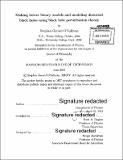| dc.contributor.advisor | Scott A. Hughes. | en_US |
| dc.contributor.author | O'Sullivan, Stephen Gerard | en_US |
| dc.contributor.other | Massachusetts Institute of Technology. Department of Physics. | en_US |
| dc.date.accessioned | 2015-10-14T15:04:05Z | |
| dc.date.available | 2015-10-14T15:04:05Z | |
| dc.date.copyright | 2015 | en_US |
| dc.date.issued | 2015 | en_US |
| dc.identifier.uri | http://hdl.handle.net/1721.1/99297 | |
| dc.description | Thesis: Ph. D., Massachusetts Institute of Technology, Department of Physics, 2015. | en_US |
| dc.description | Cataloged from PDF version of thesis. | en_US |
| dc.description | Includes bibliographical references. | en_US |
| dc.description.abstract | In this thesis, I discuss the application and development of black hole perturbation theory both from an observational standpoint via gravitational waves and also tidal distortions of black hole horizons. The promise of gravitational wave astronomy depends on our ability to accurately model gravitational wave signals from astrophysical sources. This requires large numbers of accurate theoretical template waveforms spanning large regions of parameter space to be cross-correlated against the output of gravitational-wave detectors. Numerical simulations of binary black-hole evolution are now possible but remain CPU costly. They also have problems with small mass ratios where perturbative analyses are efficient. This high computational cost has motivated the development of the effective-one-body (EOB) formalism, a framework which models the three phases of binary black hole coalescence - inspiral, plunge/merger, and ring down - by combining information from a variety of modeling techniques. In this thesis, we combine EOB with black hole perturbation theory to study the transition from inspiral to plunge-merger and ringdown. This allows us to tune and improve the accuracy of EOB. In Newtonian gravity, tidal coupling between members of a binary system has an influence on that binary's dynamics. There are also well-understood connections between the geometry of the binary's distorted members and the impact of tides on the orbit's evolution. In this thesis we develop tools for investigating the tidal distortion of black holes for tides arising from a body in a bound orbit. We also develop tools to visualize the horizon's distortion for black hole spin a/M < V/3/2. In analyzing how a Kerr black hole is distorted by a small body for a circular equatorial orbit, we find that Newtonian intuition is not applicable. We also apply these techniques to generic Kerr black hole orbits, which enables us to look at time-dependent phenomena on the horizon. In particular, we find significant offsets between the applied tide and the horizon's response, as well as small amplitude coherent wiggles in the horizon's shear response to the applied tide. These appear to arise from the teleological nature of the horizon's response to tides. | en_US |
| dc.description.statementofresponsibility | by Stephen Gerard O'Sullivan. | en_US |
| dc.format.extent | 226 pages | en_US |
| dc.language.iso | eng | en_US |
| dc.publisher | Massachusetts Institute of Technology | en_US |
| dc.rights | M.I.T. theses are protected by copyright. They may be viewed from this source for any purpose, but reproduction or distribution in any format is prohibited without written permission. See provided URL for inquiries about permission. | en_US |
| dc.rights.uri | http://dspace.mit.edu/handle/1721.1/7582 | en_US |
| dc.subject | Physics. | en_US |
| dc.title | Making better binary models and modeling distorted black holes using black hole perturbation theory | en_US |
| dc.type | Thesis | en_US |
| dc.description.degree | Ph. D. | en_US |
| dc.contributor.department | Massachusetts Institute of Technology. Department of Physics | |
| dc.identifier.oclc | 922893939 | en_US |
